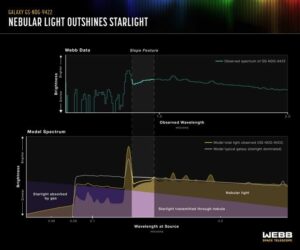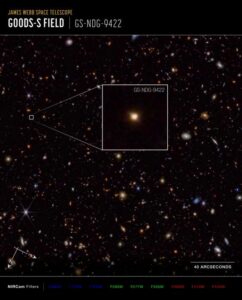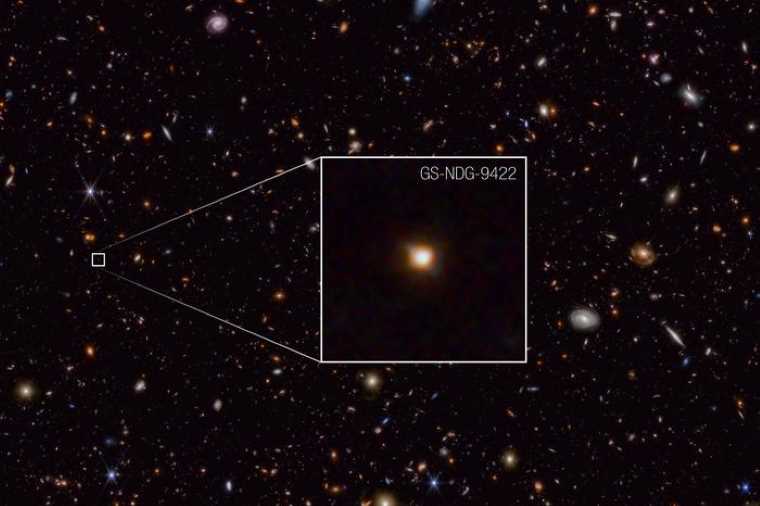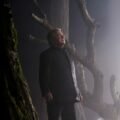Scientists using the James Webb Space Telescope say they have spotted a “weird” galaxy containing “exotic” stars that may represent the Universe’s “missing link” phase of galactic evolution.
“My first thought in looking at the galaxy’s spectrum was, ‘That’s weird,’” said Dr. Alex Cameron from the University of Oxford and the team’s lead researcher behind the discovery.
Dubbed GS-NDG-9422 (9422), the distant galaxy formed about one billion years after the Big Bang has a unique feature never seen before: its gas seems to outshine its stars. According to the researchers, this unusual feature could mean the weird galaxy is actually a galactic missing link between the universe’s first stars and the more familiar, “well-established” galaxies we see today.
If confirmed, the discovery could help astronomers understand the universe’s evolution during a poorly understood phase. It also shows how the JWST continues to provide unprecedented discoveries that continue to rewrite our understanding of the cosmos.
“[This] is exactly what the Webb telescope was designed to reveal: totally new phenomena in the early Universe that will help us understand how the cosmic story began,” said Cameron.
Why Does the Gas Cloud Surrounding Weird Galaxy 9422 Outshine its Stars?
After spotting the unusual spectral reading from galaxy 9422, Cameron says he reached out to colleague and theorist Dr. Harley Katz of Oxford and the University of Chicago. The researchers explored several galactic models to see if any would fit the team’s unexpected data. That effort revealed one class of galactic models that seemed to fit: extremely hot, massive stars that heat the galactic gas cloud around them enough to make their light signature brighter than the stars’ spectral signature.
“It looks like these stars must be much hotter and more massive than what we see in the local Universe, which makes sense because the early Universe was a very different environment,” Katz explained.


According to the researchers, the hot, massive stars found in the “local” universe have a temperature range between 70,000 and 90,000 degrees Fahrenheit, or about 40,000 to 50,000 degrees Celsius. However, the stars Cameron and his team spotted appeared to be closer to 140,000 degrees Fahrenheit or about 80,000 degrees Celsius.
Based on the observed data and these new computer models, Cameron and Katz suspect that their weird galaxy is currently experiencing a phase of intense star formation. They also believe this is happening within a massive, dense cloud of gas, increasing the production of hot, massive stars. Combined, the team says these factors are resulting in the unusual light signature where the gas is brighter than the stars.
“The gas cloud is being hit with so many photons of light from the stars that it is shining extremely brightly,” the press release announcing the team’s findings explains.
Exotic Stars and Galactic Evolution
While galactic evolution models previously predicted nebular gas outshining its stars, the team says it is usually only expected in the universe’s first generation of galaxies containing a different class of stars. Called Population III stars, these stellar bodies are believed to have evolved millions of years before galaxy 9422. According to the researchers, the readings from the JWST show that this newly discovered weird galaxy could not be made up of Population III stars.
“We know that this galaxy does not have Population III stars because the Webb data shows too much chemical complexity,” Katz explained.


This combination of traits found in early-universe stars and the stars astronomers are more familiar with in the present-day cosmos means that the team may have stumbled upon a “missing-link” galaxy representing a phase transition between the early and modern universe.
“[T]he exotic stars in this galaxy could be a guide for understanding how galaxies transitioned from primordial stars to the types of galaxies we already know,” said Katz.
Hunting For More Examples of Missing Link Galaxies
While an intriguing concept, the researchers say 9422 is merely one example of this phase transition. It could be a typical example of galaxies formed during this phase, or it could truly represent a rare, weird galaxy.
Moving forward, the team says they are now “identifying more galaxies” to see if they can find additional examples that fit this cosmic time and structure. If successful, they believe they can answer many standing questions regarding the state of the universe one billion years after the Big Bang and how the early universe transitioned into the one we see today. Fortunately, the team finally has the tools to accomplish this lofty goal.
“It’s a very exciting time to be able to use the Webb telescope to explore this time in the Universe that was once inaccessible,” Cameron said. “We are just at the beginning of new discoveries and understanding.”
The study “Nebular-dominated galaxies: insights into the stellar initial mass function at high redshift” was published in the Monthly Notices of the Royal Astronomical Society.
Christopher Plain is a Science Fiction and Fantasy novelist and Head Science Writer at The Debrief. Follow and connect with him on X, learn about his books at plainfiction.com, or email him directly at christopher@thedebrief.org.

